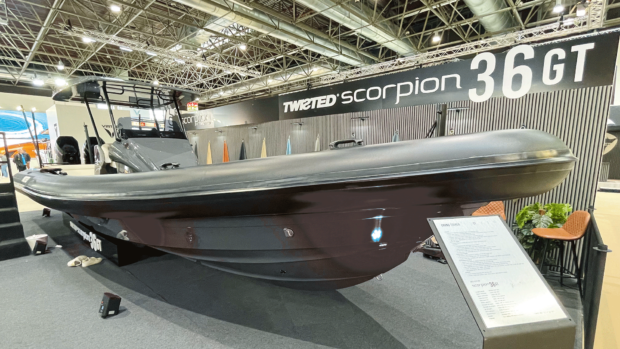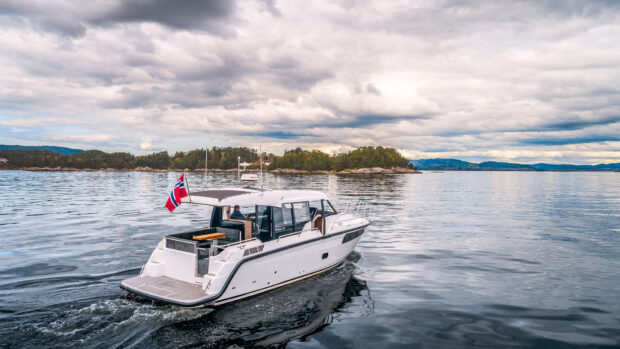Caudwell Marine’s new Axis-drive diesel outboard promises the performance and handling of a petrol engine with the efficiency and reliability of a diesel one. Hugo Andreae takes a closer look
Not so long ago the idea of a 300hp diesel outboard engine seemed an impossible dream but with both Cox and Oxe now offering just that, it’s clear that the technology is available and the demand exists.
Now, a third player is promising to disrupt the market all over again with its own distinctive take on a gutsy but fuel- efficient diesel outboard engine.
Developed and built by Caudwell Marine in the UK, the new 300hp turbodiesel outboard can trace its roots back to the original Caudwell Axis sterndrive first shown to journalists in 2009.
Clever as that concept was, it never took off, partly because it required boat builders to design a bespoke angled transom and engine bay, and partly because it was offered with a selection of converted car engines with little or no track record of marine use.
Reinventing the concept as an outboard engine that fits onto a standard transom solves the first issue while the adoption of a well-proven diesel powerhead with a marine pedigree solves the second.

Commercial operators are likely to be attracted by its lower running costs
There’s clearly more to it than that but the end result shares some of the core engineering benefits that made the original Axis drive such an interesting proposition.
Proven diesel power
The powerhead itself is a tried-and-tested 3.0-litre V6 turbo diesel built by VM Motori in Italy, originally for use in cars such as the Jeep Grand Cherokee and Maserati Levante, but also marinised and used by Mercury for its 270hp 3.0 TDI sterndrive.
Uprated to 300hp for this application, it uses a robust cast iron block with a high-pressure common rail injection system for improved efficiency and a dry sump oil recovery system for effective oil circulation regardless of orientation.
Article continues below…

Best hybrid diesel electric boats: The best of both worlds?

Diesel outboard head-to-head test: Cox CXO 300hp vs Oxe 200hp
Although that 300hp power output is an important figure for outboard enthusiasts, it’s the engine’s strong torque characteristics and low fuel consumption that are likely to be its main selling points.
Caudwell is claiming a peak torque of 590Nm at 2,200rpm, almost twice as much as a typical 300hp petrol engine, suggesting strong mid-range acceleration, relaxed cruising at speed and the ability to power much heavier boats than would normally be the case. It’s yet to publish detailed fuel burn rates but it is expected to show savings of at least 30% over a comparable petrol engine.

Only the bottom section of the engine pivots when steering
Unusually, the powerhead is mounted at a 60° angle, with the driveshaft running down through the leg at the same angle, whereas almost all outboard engines, including the Cox CXO 300 diesel, use vertically mounted engine blocks with a driveshaft running straight down the leg to the transfer box (the Oxe is an anomaly as it uses a horizontal block with a belt- drive pulley system).
The Caudwell’s angled drive shaft feeds into a sophisticated twin-clutch gearbox from gearing specialist ZF that makes for exceptionally smooth transitions into and out of gear and even allows you to go from full ahead to full reverse (known as an emergency crash stop) without damaging the engine.
Cauldwell Axis-drive steering
However, the defining feature of the new Caudwell outboard is its patented Axis-Drive integrated steering system. A bit like Mercury’s 600hp V12, the main body of the engine stays fixed, leaving only the articulating lower leg to swing from side to side.
The difference with the Axis-Drive system is that it pivots around an angled joint so that it tilts the thrust downwards as it turns for a faster drive through the turn, and sharper, more agile handling.

The original Caudwell Axis-drive used a canted inboard engine linked to stainless steel sterndrives
The innovation continues all the way down to the drive unit, which features twin counter-rotating propellers for more efficient transfer of power to the water, meaning faster acceleration and turns as well as more cost-effective cruising. Currently, the only outboard engines to offer duo-prop drive are Mercury’s 600hp V12 and Suzuki’s flagship 300-350hp range.
Other stated benefits include easy access to the powerhead through a pair of large opening top hatches and a power trim and tilt mechanism contained within the main engine bracket for superior corrosion resistance and reliability.
The latter is likely to be a key battleground for Caudwell, not just because this is critical to any new engine builder’s success but also because the business case for buying a diesel outboard engine relies on the fuel and servicing savings accrued over a large number of engine hours.

A rendering of how the new Caudwell diesel outboards will look
Although Caudwell has not yet released pricing for its new engine, it is likely to be around two to three times the cost of a 300hp petrol outboard. That’s why in the short term it envisages the bulk of its customers being either commercial or military, where regular daily use will result in a quicker payback time.
The engines themselves will be assembled at a new manufacturing facility outside Kidderminster, with the first production units scheduled for delivery this summer. Caudwell claims to have completed over 19,000 hours of sea trials and 4,000 hours of laboratory testing to try and iron out any teething troubles.
Given that it’s wading into battle with two established players, it will need to hit the ground running but if it can deliver the spritely performance and handling of the original Axis drive, with the reliability and efficiency of a diesel outboard engine, it should prove to be a formidable combination.
Cauldwell Axis-drive diesel specifications
Size: 3.0 litre
Type: V6 turbo
Orientation: 60°
Max Power: 300hp
Max RPM: 4,200rpm
Max Torque: 590Nm
Weight: 380kg
Price: TBA









